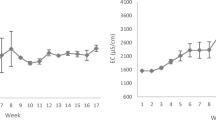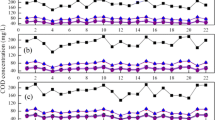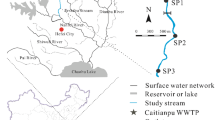Abstract
The objective of the study is to improve understanding of natural phosphorus removal processes to limit the need for chemical addition in an existing facultative wastewater stabilization pond in Manitoba, Canada. Surface samples were collected from lagoon cells and analyzed. The windward and leeward sides of the ponds were sampled and the results were averaged. Phosphorus appears to be removed by assimilation into biomass; and precipitation at alkaline pH. When the nitrogen to phosphorus (N/P) ratio and ideal theoretical N/P ratio for cellular growth are compared, there appears to be nitrogen-limiting conditions in the secondary cells of the stabilization system. There is evidence ammonia removal by free ammonia volatilizing to the atmosphere may be contributing to nitrogen-limiting conditions in the secondary lagoon cells. Additional nitrogen may need to be supplied to remove more phosphorus by assimilation into biomass.






Similar content being viewed by others

References
APHA. (2005). Standard methods for the examination of water and wastewater. Washington, DC: American Public Health Association, American Water Works Association, and Water Environment Federation.
Becker, E. W. (1994). Microalgae: Biotechnology and microbiology. Cambridge: Cambridge University Press.
Beuckels, A., Smolders, E., & Muylaert, K. (2015). Nitrogen availability influences phosphorus removal in microalgae-based wastewater treatment. Water Research, 77, 98–106.
Boelee, N. C., Temmink, H., Janssen, M., Buisman, C. J. N., & Wijffels, R. H. (2012). Scenario analysis of nutrient removal from municipal wastewater by microalgal biofilms. Water, 4, 460–473.
Brown, N., & Shilton, A. (2014). Luxury uptake of phosphorus by microalgae in waste stabilisation ponds: current understanding and future direction. Review Environmental Science & Biotechnology, 13, 321–328.
Carlsson, H., Aspegren, H., Lee, N., & Hilmer, A. (1997). Calcium phosphate precipitation in biological phosphorus removal systems. Water Research, 31(5), 1047–1055.
Cho, D., Ramanan, R., Heo, J., Kang, Z., Kim, B., Ahn, C., Oh, H., & Kim, H. (2015). Organic carbon, influent microbial diversity and temperature strongly influence algal diversity and biomass in raceway ponds treating raw municipal wastewater. Bioresource Technology, 191, 481–487.
Chorus, I. & Bartram, J. (eds). (1999). Toxic cyanobacteria in water: A guide to their public health consequences, monitoring and management. World Health Organization.
Converti, A., Casazza, A. A., Ortiz, E. Y., Perego, P., & del Borghi, M. (2009). Effect of temperature and nitrogen concentration on the growth and lipid content of Nannochloropsis oculata and Chlorella vulgaris for biodiesel production. Chemical Engineering Processes, 48, 1146–1151.
European Science Foundation (ESF). (1999). Cyanobacteria nitrogen fixation (CYANOFIX). IREG Strasbourg, Order No. 993098.
Griffiths, E. W. (2009). Removal and utilization of wastewater nutrients for algae biomass and biofuels. MSc Thesis. Utah State University.
Hach Company. (2014). TNT 845 Phosphorus total phosphorus reactive (ortho). Loveland, CO.
Larsdotter, K. (2006). Microalgae for phosphorus removal from wastewater in a Nordic climate. PhD thesis, Royal Institute of Technology School of Biotechnology; Stockholm, Sweden.
Larsdotter, K., la Jansen, J. C., & Dalhammar, G. (2007). Biologically mediated phosphorus precipitation in wastewater treatment with microalgae. Environmental Technology, 28, 953–960.
Larsdotter, K., la Jansen, J. C., & Dalhammar, G. (2010). Phosphorus removal from wastewater by microalgae in Sweden—a year-round perspective. Environmental Technology, 31(2), 117–123.
Lin, J., Qiu, P., Yan, X., Xiong, X., Jing, L., & Wu, C. (2015). Effectiveness and mode of action of calcium nitrate and Phoslock® in phosphorus control in contaminated sediment, a microcosm study. Water Air Soil Pollution, 226, 330.
Marais, G. V. R. (1974). Faecal bacterial kinetics in stabilization ponds. Journal Environmental Engineering, 100(2), 119–139.
Mbwele, L.A. (2006). Microbial phosphorus removal in waste stabilisation pond wastewater treatment systems. Ph.D. Dissertation. Royal Institute of Technology School of Biotechnology; Stockholm, Sweden.
Metcalf and Eddy. (2003). Wastewater Engineering Treatment and Reuse (4th ed.). New York, NY: McGraw Hill.
Middlebrooks, E. J., Middlebrooks, C. H., Reynolds, J. H., Watters, G. Z., Reed, S. C., & George, D. B. (1982). Wastewater stabilization lagoon design, performance and upgrading. New York: Macmillan Publishing Co., Inc.
Pires, J. C. M., Alvim-Ferraz, M. C. M., Martins, F. G., & Simões, M. (2013). Wastewater treatment to enhance the economic viability of microalgae culture. Environmental Science and Pollution Research, 20, 5096–5105.
Puig, S., Serra, M., Coma, M., Cabré, M., Balaguer, M. D., & Colprim, J. (2010). Effect of pH on nutrient dynamics and electricity production using microbial fuel cells. Bioresource Technology, 101, 9594–9599.
Rockne, K. J., & Brezonik, P. L. (2006). Nutrient removal in a cold-region wastewater stabilization pond: importance of ammonia volatilization. Journal of Environmental Engineering, 132(4), 451–459.
Solovchenko, A., Khozin-Goldberg, I., Didi-Cohen, S., Cohen, Z., & Merzlyak, M. (2008). Effects of light intensity and nitrogen starvation on growth, total fatty acids and arachidonic acid in green microalga Parietochloris incisa. Journal Applied Phycology, 20, 245–251.
Song, Y., Hahn, H. H., & Hoffmann, E. (2002). Effects of solution conditions on the precipitation of phosphate for recovery: a thermodynamic evaluation. Chemosphere, 48, 1029–1034.
Stumm, W., & Morgan, J. J. (1981). Aquatic chemistry: an introduction emphasizing chemical equilibria in natural waters. New York: Wiley.
Tam, N. F. Y., & Wong, Y. S. (2000). Effect of immobilized microalgal bead concentrations on wastewater nutrient removal. Environment Pollution, 107(1), 145–151.
Tuszynska, A., Kolecka, K., & Quant, B. (2013). The influence of phosphorus fractions in bottom sediments on phosphate removal in semi-natural systems as the 3rd stage of biological wastewater treatment. Ecological Engineering, 53, 321–328.
United States Environmental Protection Agency (US EPA). (1983). Design manual: municipal wastewater stabilization ponds. EPA-625/1-83-015.
Von Sperling, M. (2007). Wastewater stabilization ponds. London: IWA Publishing.
World Health Organization (WHO). (2002). Sanitation: controlling problems at source. prepared for water, sanitation and health. Written by Dr. Rosalind Stanwell Smith and reviewed by the Water and Sanitation Programme, World Bank and the Water, Sanitation and Health Unit (WSH), World Health Organization.
Acknowledgments
Financial assistance for this project was provided by NSERC (EGP 478375-2015).
Author information
Authors and Affiliations
Corresponding author
Electronic supplementary material
Below is the link to the electronic supplementary material.
ESM 1
(DOCX 246 kb)
Rights and permissions
About this article
Cite this article
Vendramelli, R.A., Vijay, S. & Yuan, Q. Phosphorus Removal Mechanisms in a Facultative Wastewater Stabilization Pond. Water Air Soil Pollut 227, 417 (2016). https://doi.org/10.1007/s11270-016-3130-6
Received:
Accepted:
Published:
DOI: https://doi.org/10.1007/s11270-016-3130-6



